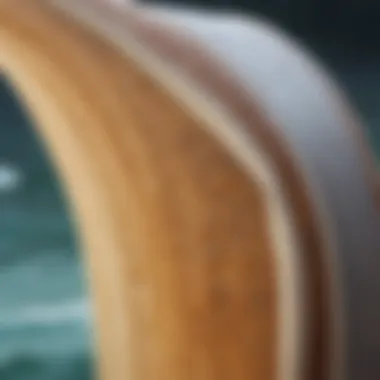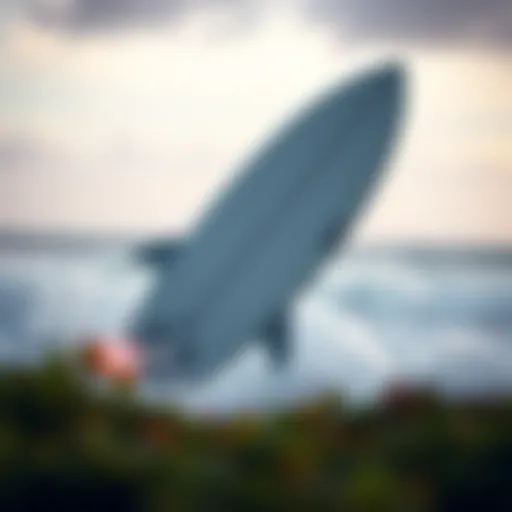Understanding Surfboard Fins: Importance and Function


Intro
Surfing is an exhilarating sport, where the connection between a surfer and the ocean unfolds in waves. Yet, behind this romantic image lies the precision of equipment, specifically surfboard fins, that significantly impact performance. Fins are like the unsung heroes of a surfboard, quietly influencing how a rider interacts with the water. This article dives into the mechanics and relevance of surfboard fins, offering insights that both novices and seasoned surfers will find invaluable.
From the types of fins available to their mounting positions and materials, understanding these components can mean the difference between a close encounter with the wave crest and an impressive carve that sends you flying. Imagine the feel of controlling your board with ease as you slice through a perfect wave, all thanks to the right fin choice.
This discussion goes beyond mere elements of design—it touches the evolution of surf culture as technology advances. Let’s embark on a journey to uncover the crucial details surrounding surfboard fins, revealing their palpable influence in the world of surfing.
The Fundamental Role of Fins in Surfboarding
Fins may seem like simple constructs attached to the bottom of a surfboard, but their function is anything but trivial. They play a crucial role in the overall dynamics of surfing, impacting everything from speed and control to how well you adapt to various wave conditions. Understanding the importance of fins goes beyond just picking a style; it’s about grasping how they alter your ride.
Understanding Surfboard Dynamics
At the heart of surfing is the interaction between the surfer and the board. Fins serve as the primary means of connecting the board to the water. When a surfer shifts their weight, the fins help translate those movements into direction and stability. Each fin's shape, size, and placement influence how the board behaves in the water. The right fin setup can mean the difference between a smooth carve and a frustrating spinout.
To visualize this, picture yourself trying to steer a kayak. Just as the kayak’s rudder directs its path, fins guide a surfboard. When used correctly, they allow for precise turns and swift accelerations. A good understanding of how the fins interact with the waves and the surfer's movement can significantly enhance a surfing experience.
Influence on Speed and Control
Speed and control are often intertwined in surfing. Fins enable surfers to gain speed through their turns while also providing the necessary grip to maintain control. You can think of fins as the unsung heroes that lend stability to your rides.
For instance, larger fins generally offer more grip in the water but can slow down your speed due to increased drag. Conversely, smaller fins might facilitate faster turns but could leave you feeling wobbly, especially in choppy conditions. This balance plays a significant role in how well a surfer can maneuver their board. The process of selecting fins becomes about more than aesthetics; it becomes a strategic choice rooted in performance.
Adaptation to Wave Conditions
Wave conditions can change in the blink of an eye, and a fin's adaptability is paramount. Surfers often face varying conditions—be it a gentle swell or powerful, choppy waves. Fins can be tailored to suit these shifting circumstances, altering characteristics such as lift, drag, and responsiveness.
In smaller, slower waves, a thruster setup may provide the stability needed to keep up speed while also facilitating quick turns. In contrast, during high-powered conditions, a quad fin setup might offer better control, akin to having four paws on a jungle floor, ensuring a firmer grip on the chaotic water.
Types of Surfboard Fins
Fins on surfboards come in various shapes and configurations that can profoundly influence a surfer's performance on the water. Choosing the right type of fin can determine how well a surfer can maneuver, control speed, and adapt to different wave conditions. By understanding the unique characteristics and benefits of each fin type, surfers can make informed decisions, whether they are novices seeking foundational knowledge or seasoned riders looking to refine their technique.
Single Fins: Classic Simplicity
The single fin setup harks back to the origins of modern surfing, embodying the classic aesthetic. This type typically consists of one central fin located at the tail of the board. It’s known for offering straight-line speed and a smooth glide, which makes it ideal for open-face waves and when practicing turns. The simplicity of the design allows for a fluid surfing style, with surfers often enjoying a feeling of flow.
Moreover, the single fin’s stability can be particularly beneficial for beginners as it builds confidence in balancing on the board. However, it might not provide the sharp turns or quick responsiveness that some advanced surfers crave, making it more suited for laid-back styles and traditional longboards.
Twin Fins: Speed and Agility
Twin fins, featuring a pair of fins on either side of the board, are renowned for their speed and agility. This design promotes quicker transitions and fun, lively rides, benefiting performance in smaller, punchy waves. The reduced drag offered by the two fins enables surfers to harness their energy during explosive turns.
Surfers often favor this setup for its ability to execute slick maneuvers and achieve a distinct flow. Twin fins are especially popular in fish-shaped boards, where the wider outline complements the added speed. However, while they shine in certain conditions, they may lack the stability needed in choppier waters, requiring a bit more skill to maintain control.
Thruster Fins: Versatility and Balance
Thruster fins, with their three-fin configuration, stands as one of the most popular fin setups among modern surfers. This design balances speed, flow, and maneuverability, allowing for a versatile approach to diverse wave conditions. The central fin acts as a stabilizer, while the two side fins enhance turn responsiveness.
This fin setup is ideal for both shortboards and longboards and often seen in competitive surfing. A thruster allows surfers to engage in powerful turns while maintaining stability, making it suitable for various skill levels. The equilibrium it provides encourages experimental approaches and greater confidence among riders.
Quad Fins: Enhanced Drive and Tail Control
Quad fins consist of four fins arranged in a way that maximizes speed and tail control. This setup excels in generating drive and is particularly effective in larger, steeper waves. The additional fins at the back end provide superior grip, allowing for powerful turns and cutbacks.
Surfers often appreciate how well quad setups respond in challenging conditions, as they balance speed and control effectively. However, riders transitioning from thrusters might need time to adjust, as the sensation and feedback from quad fins can differ considerably from other fins configurations.


Alternative Fin Designs
Surfing is an evolving sport, and as such, alternative fin designs have emerged to cater to specialized needs. From Bonzer fins that offer a unique concave design, enhancing speed and responsiveness, to channels that redirect water flow for more stability, these innovative fins can diversify a surfer’s experience. Some riders even explore flexible fins, which can adapt to varying conditions, providing an interesting mixture of responsiveness and power.
These alternative designs often cater to niche surfing styles and preferences. Being open to experimenting with different fin types can lead to discovering a more tailored surfing experience, enhancing personal enjoyment and performance on the water.
Fin Design and Construction
The design and construction of surfboard fins play a crucial role in their functionality, significantly affecting the performance and behavior of a surfboard in various wave conditions. A fin needs to blend physical attributes with engineering principles, ensuring it not only stands up to the marine environment but also complements the surfer's style.
A properly designed fin does not merely exist to keep the board pointed straight; rather, it serves a diverse set of purposes. It channels water flow, minimizes drag, and maximizes thrust—all while providing the necessary grip when carving turns or navigating turbulent waters. Understanding the intricate relationship between the fin's shape, size, and positioning is essential for both beginner and seasoned surfers alike. It's like having a tailored suit as compared to off-the-rack: one fits better and performs more effectively.
Materials Used in Fin Production
The choice of materials used in fin production is pivotal to performance characteristics. Traditional fins are often crafted from fiberglass or plastic.
- Fiberglass: Known for its strength and flexibility, fiberglass fins can flex under pressure, offering a blend of rigidity and responsiveness that many surfers appreciate.
- Plastic: Lighter and often less expensive, these fins are ideal for those just starting their surfing journey.
- Carbon Fiber: This is gaining traction among advanced surfers due to its lightweight nature and unparalleled stiffness, enhancing both speed and control on the wave.
Each material impacts not just durability but also how a surfer can manipulate their board during rides, making the decision about fin material a fundamental consideration in surfboard setup.
Technology in Fin Engineering
Recent advancements in fin technology have revolutionized how surfers approach performance. Computational fluid dynamics, for instance, allows manufacturers to simulate various fin shapes and surface textures under wave conditions before a single fin is produced.
- Hydrodynamic Design: Fins are engineered to disrupt water flow in desirable ways, whether to reduce resistance or enhance lift.
- 3D Printing: This allows for rapid prototyping and testing of new designs, fostering an era of innovation that can respond quickly to surfer feedback.
- Custom Fittings: With technologies that allow surfers to customize fin shapes and angles based on personal preferences, the days of one-size-fits-all are quickly fading.
These technological advancements are not merely gimmicks; they add significant value by allowing for tailoring setups that align with a surfer's individual skill level and style.
Aesthetic Considerations in Design
While performance is paramount, the aesthetic aspect of fin design should not be overlooked. Fins often serve as a canvas for personal expression, reflecting a surfer's personality.
- Color and Patterns: Many companies now offer fins in various colors and designs, allowing surfers to match their gear or express individuality.
- Brand Identity: Some fins carry branding that could signify allegiance to a particular surf lifestyle or surfwear company.
- Cultural Influences: Designs can also reflect cultural motifs or symbols significant to specific surfing communities, adding another layer of connection to the water.
A well-designed fin is thus not only a functioning part of the surfboard but also an accessory that carries deeper meaning and personal significance for the swimmer.
"Fins are where art meets engineering, and that intersection is where the soul of surfing lives."
In summary, a solid understanding of fin design and construction paves the way for better performance and more enjoyable surfing experiences. By choosing the right materials, leveraging advanced technologies, and appreciating the role of aesthetics, surfers can greatly enhance their connection to the waves.
Fin Placement and Configuration
The placement and configuration of fins on a surfboard play a pivotal role in how the board performs on the water. Surfers often overlook this element when selecting their boards, yet it can drastically influence the ride's maneuverability, speed, and overall enjoyment. Understanding fin placement is essential for both novice and experienced surfers aiming to maximize their performance on waves.
Understanding Fin Placement
Fin placement refers to the positioning of the fins on the surfboard relative to various factors, including the board's length, design, and intended use. For instance, moving fins closer to the tail can increase responsiveness, allowing for sharper turns and more agility. This setup suits surfers who prefer quick maneuvers in smaller waves.
Conversely, placing fins further up the board can enhance drive and stability, beneficial for larger waves or those looking to maintain speed. Recognizing how fin positioning interacts with wave conditions can elevate a surfer's skill set.
"Positioning fins correctly is like having the right shoes for a dance; it can make or break your performance on the water."
Some key considerations when it comes to fin placement include:
- Type of waves: Smooth or choppy, small or large, each wave type may demand adjustments in fin configuration.
- Surfboard length: Longer boards can allow for varied fin placement options without compromising stability.
- Personal preference: Each surfer has a unique style, which can dictate how they set up their fins.
Adjusting Fin Angles for Performance
Fin angles, or cant angles, refer to how the fins are tilted in relation to the board's bottom surface. Adjusting these angles can significantly modify the handling of the surfboard. For example, increasing the cant angle can enhance a surfer's ability to carve through turns, providing more grip when engaging with the wave.


Surfers who like to shred may prefer a greater angle on their fins as it allows better engagement in fast, tricky maneuvers. On the other hand, a less angled setup might suit those who enjoy a more cruisy ride. Every adjustment comes with its pros and cons, and understanding these can lead to better decision-making when configuring a surfboard.
The Impact of Tail Shape on Fin Function
The tail shape of a surfboard affects how fins work together as a system. A wider tail typically provides more lift and drive, which can work in conjunction with certain fin placements. On the flip side, a narrower tail allows for quicker transitions and tight turns. This interplay can dictate whether a surfer is surfing hard on a wave or smoothly gliding.
It's essential to recognize how fin systems get affected by tail shapes. For instance:
- Squash tails allowing for both speed and maneuverability may work best with thruster setups.
- Pin tails lend themselves toward stability and may require quad fins for robust performance in powerful waves.
Understanding these dynamics can help surfers refine their craft while adding layers to their surfing experience. The relationship between fin placement, angles, and tail design is integral to riding properly and efficiently.
Maintenance and Care of Fins
Maintaining surfboard fins is vital not just for maximizing performance, but also for prolonging their lifespan. FIns are often the unsung heroes of a surfer's arsenal, playing a fundamental role in ensuring that your board handles well in various conditions. A fin in prime condition can mean the difference between a smooth ride and a frustrating session on the waves. Therefore, regular maintenance and care are paramount.
Cleaning Fins for Optimal Performance
A clean fin contributes significantly to better performance. Dirt, sand, or even salt buildup can impede the water flow around the fin, leading to sluggishness and reduced agility. To clean your fins effectively, follow these steps:
- Rinse with Fresh Water: After every surf session, rinse the fins thoroughly with fresh water to remove salt and sand. This simple act can prevent corrosion and build-up.
- Use Mild Soap: If you notice stubborn grime, a mild soap without harsh chemicals can work wonders. Just a little scrub with a soft brush will restore them to their original shine.
- Dry Properly: Avoid leaving fins wet for extended periods; moisture can cause damage over time. Dry them off with a towel before storing.
Not only does regular cleaning improve performance, but it also enhances aesthetics, keeping your fins looking sharp.
Detecting and Repairing Damage
Fins, being in constant contact with the waves, are susceptible to chips, cracks, or even complete breakage. Regular inspections are crucial to catch issues before they escalate. Here’s how to go about it:
- Visual Inspection: Look closely at your fins after every surf. Check for any visible damage like chips or fractures.
- Flex Test: Gently flex the fin to see if it feels unusually weak or has any odd sounds when moved. A stable fin should maintain its shape and firmness.
- Patch Up: If you find any minor cracks, you can use marine-grade epoxy for repair. Just make sure to follow the instructions and allow adequate drying time.
Ignoring damage can affect performance, so be proactive about checks and repairs.
Storage Practices to Extend Lifespan
How you store your fins can greatly influence their longevity. Improper storage can lead to warping, scratches, or unnecessary wear. Keep these pointers in mind:
- Store in a Cool, Dry Space: Avoid exposure to direct sunlight as UV rays can weaken the material over time. Use a storage bag if possible.
- Separate from the Board: If possible, detach fins from the board during storage. This prevents any pressure or stress that might occur while compressed against the board.
- Use a Fin Wallet: Investing in a specialized fin wallet helps keep your fins organized and safe from damage.
Following these storage tips will help ensure your fins stay in great shape for many surf sessions to come.
Proper maintenance of surfboard fins not only enhances performance but also drastically extends their lifespan. A little care goes a long way in the surfing world.
Fins and Environmental Considerations
Understanding the environmental implications of surfboard fins and their production is crucial in the context of rising global awareness regarding sustainability. As surfing continues to grow in popularity, the demand for surfboards and their components, particularly fins, places increasing pressure on nature. This section explores how selecting eco-friendly materials and embracing sustainable practices can mitigate the negative impact on our precious oceans and ecosystems.
Eco-Friendly Materials in Fin Production
The use of eco-friendly materials in the production of surfboard fins is not just a trend; it's a necessity for conscious consumers and manufacturers alike. Traditional materials like fiberglass and polyurethane have long been staples in the industry but come with their environmental baggage. In contrast, newer materials such as bio-resins and recycled plastics are gaining traction.
- Bio-resins are derived from renewable resources, unlike petroleum-based resins. These materials bond strength is impressive, ensuring that fins remain durable while reducing carbon footprints.
- Recycled plastics sourced from discarded fishing nets or other ocean waste can be processed into new fins. This not only helps keep harmful debris out of the ocean but also promotes a circular economy.
Manufacturers like Sustainable Surf and RinseKit have been pioneers in pushing the envelope with their innovative, green fin solutions, showcasing that sustainability and performance can go hand in hand. The switch to eco-conscious materials is still gaining momentum, but as awareness grows, so too does the consumer demand for such products.
"As surfers, we owe it to the ocean to practice a sustainable approach. Our fins should do the same, supporting not just our ride but the health of the waters we love."
Sustainable Practices in Surfboarding


Beyond materials, sustainable practices in surfboarding represent another facet of protecting our environment. It’s about cultivating a philosophy that transcends the act of riding waves and extends to how boards, fins, and gear are made, used, and disposed of.
- Reduction of Waste: Manufacturers who embrace lean production techniques aim to minimize waste during the fin-making process. This involves careful planning and design, ensuring that each piece cut from raw materials is utilized effectively.
- Longevity of Products: Producing fins that are meant to last longer not only reduces waste but also allows surfers to decrease how often they buy replacements. Brands that focus on quality over quantity encourage consumers to invest in durable, repairable products, promoting a waste-free surfing experience.
- Community Initiatives: Brands like Firewire Surfboards and Sustainability in Surfing engage in community awareness programs, organizing beach clean-ups and educational sessions about environmental responsibility. Connecting surfers with their local environments strengthens the bond between sport and nature.
- Second-Hand Market: Promoting the resale of used fins and boards encourages a culture of reuse. Platforms such as Reddit or Facebook groups dedicated to surf gear trading provide spaces for enthusiasts to buy and sell gently-used fins, reducing demand for new production.
The Cultural Impact of Fins in Surfing
Surfing isn’t just a sport; it’s a way of life for many. Fins, often overlooked, play a pivotal role in shaping this culture. They serve not only as tools of performance but as symbols of individuality and innovation within the surf community. Understanding the cultural impact of fins in surfing requires an appreciation for their historical roots and their influence on today's surfing lifestyle.
Fins in Surfing History
The evolution of surfboard fins is tied closely to the history of surfing itself. In the early days of the sport, primarily on the beaches of Hawaii, surfboards were simple wooden planks without any fins. This lack of design limited maneuverability and control on waves. However, as surfing began to spread globally in the mid-20th century, shapers started experimenting with different fin designs.
The introduction of the fin allowed surfers to carve through waves with greater agility. Historical figures, like George Greenough and his innovative designs, pushed the envelope for fin functionality. These developments weren’t just technical changes; they marked a cultural shift where surfers began expressing their individuality through board design. Each fin style came to represent different surfing techniques, changing not only how waves were ridden but also how surfers viewed themselves in relation to the ocean.
This historical context molds the way surfers perceive fins today. They are no longer just hunk o' plastic or wood attached to a board; they convey heritage and craftsmanship. Each time a surfer waxes up before heading out, they are not just preparing to ride the waves. They are tapping into a rich tapestry of history and culture, each fin telling its own story.
Influence on Modern Surf Culture
Fast-forward to contemporary surfing, and it’s clear that fins have found an even deeper cultural resonance. They reflect personal style, riding preferences, and cutting-edge advancements in technology. Modern surfers often choose fins that resonate with their identity, leading to an array of fin setups that cater to individual desires. This creates a relentless pursuit for the perfect combination that enhances performance, whether it’s speed, maneuverability, or stability.
With the advent of social media, the visual culture surrounding surfing has exploded. Surfers now showcase not just their skills but also their customized gear, including fins. Brands like FCS and Futures have made naming and designing fins into a style statement, often paired with eye-catching artwork. A fin setup can articulate a surfer’s persona, much like fashion does in the broader lifestyle realm.
The environmental aspect has also come into play with newer eco-friendly fins that appeal to socially conscious surfers. This trend not only resonates with the current plight of ocean conservation but connects the surfing community on a deeper level. Surfers become advocates for the surf culture they love, prompting discussions around sustainability and responsible surfing practices.
"Like a brushstroke on an artist's canvas, a fin’s design can transform a rider’s experience, infusing every wave caught with uniqueness and flair."
In summary, fins are far more than functional components of surfboards. They are deeply rooted in the sport's past and have significant influence over modern surf culture. From historical developments that propelled surfing into a global phenomenon to the integral role of style and sustainability today, the cultural impact of fins continues to resonate through the surfing community.
Future Trends in Fin Development
As the surfing landscape continually evolves, especially with advances in technology and environmental considerations, the future of surfboard fins stands at a peculiar crossroads. Understanding these trends is vital because they not only enhance surfing performance but also reflect surfers' growing awareness of sustainability and innovation. Insights into emerging technologies and design philosophies can help diversify the surfing experience for different skill levels and preferences. This section explores emerging innovations and how they will shape the future of surfboarding.
Innovations in Fin Technologies
Technological advancements in fin engineering are creating a new wave of possibilities for surfers. Here are several noteworthy innovations:
- Smart Fins: Integration of sensor technology into fins allows for real-time feedback on performance metrics like speed, angle, and wave conditions. Such data can revolutionize how surfers train and refine their skills.
- 3D Printing: This approach gives designers unprecedented freedom to create custom fin shapes and sizes according to individual surfer needs. This level of customization can enhance comfort and control, leading to a richer surfing experience.
- Eco-Innovations: With an eye on the planet, manufacturers are merging technology with environmental stewardship. New composite materials made from recycled plastics or bio-resins point toward sustainability without sacrificing performance.
In a nutshell, innovations in fin technology are not just shaping performance; they are redefining what surfers can expect from their equipment. The impact on the surfing community is set to be significant, as smart technology can cater to beginners and veterans alike.
Predictions for Surfer Preferences
As trends in fin development progress, the preferences of surfers will likely shift in tandem. Here are a few predictions for what might influence surfers’ choices in the near future:
- Personalization: With options for custom-made fins on the rise, more surfers will prioritize personalization over traditional choices. Expect preferences to lean heavily towards boards that speak to individual styles and techniques.
- Sustainability: As awareness grows regarding environmental issues, more surfers will opt for eco-friendly products. The desire for sustainable fins made from recyclable materials or responsibly sourced components is expected to surge.
- Performance Analytics: Surfers who once rode by feel will start relying on data. The shift towards smart fins capable of measuring performance metrics will encourage the community to embrace analytics, leading to a more informed approach to surfing.
"The evolution of fins in surfboarding is closely linked to the shifting mindset of surfers; their choices reflect deeper values about personalization and sustainability."
Keeping an eye on these trends is essential for both manufacturers and surfers alike. Understanding not just what’s popular today, but also what will shape tomorrow’s surfing landscape informs smarter, more meaningful decisions about fin designs and selections in the years to come.
Closure: The Significance of Fins in Surfboarding
In surfing, fins are more than just a component of the board; they are essential elements that significantly impact performance, maneuverability, and the overall experience on the waves. This article sheds light on how fins contribute not only to individual surfing styles but also to the evolution of surf culture itself. With the right fin setup, surfers gain control and speed, allowing them to adapt to varying wave conditions effectively. Moreover, the choice of fins influences how a surfer engages with their environment – a determinant of both fun and safety while riding the waves.
Recap of Key Points
Throughout the article, several crucial aspects of surfboard fins have been discussed:
- Role in Dynamics: Fins affect how a board interacts with water, impacting everything from stability to responsiveness.
- Variety of Types: Different fins – such as single, twin, thruster, and quad – cater to specific surfing styles and wave conditions.
- Material and Design Influence: Materials and technological advancements in the creation of fins change how they perform.
- Placement Matters: Where fins are positioned on the board can drastically alter a surfer's control and speed.
- Maintenance is Key: Proper care can extend the lifespan of fins, ensuring consistent performance.
- Cultural Relevance: Fins have not only shaped surfing history but continue to influence modern surf culture and practices.
Encouragement for Continuous Learning
Surfing is an eternal learning process. As a surfer, it’s not just about catching waves, but also about understanding the tools that make those rides possible. Since fin technology is constantly evolving, staying updated on the latest innovations and trends will help surfers optimize their experiences.
It's valuable to engage with forums and communities, like those found on Reddit or Facebook dedicated to surf culture. Here, you can find discussions about personal fin preferences, emerging designs, and tips from seasoned surfers.















